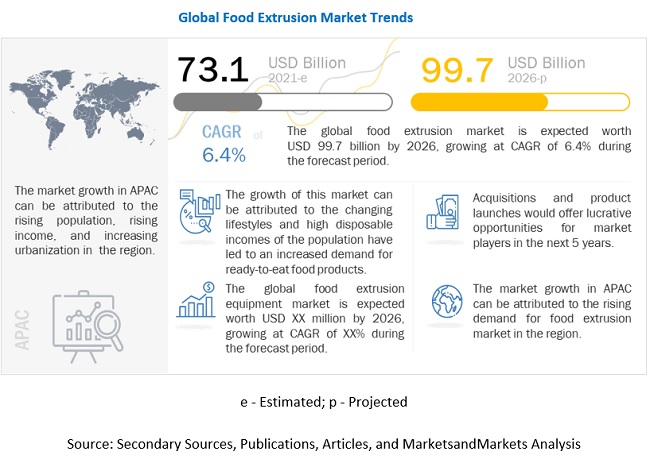The global food extrusion market is estimated to be valued at USD 73.1 billion in 2021. It is projected to reach USD 99.7 billion by 2026, recording a CAGR of 6.4% during the forecast period. The demand for Ready-To-Eat (RTE) snack foods is growing due to their convenience, nutrition value, attractive appearance, taste, and texture. Cereal-based extruded snacks are the most commonly consumed snacks. Extruders blend diverse ingredients to develop novel snack foods. The quality of the final product depends on the processing conditions used during extrusion, which include the composition of raw materials, feed moisture, barrel temperature, screw speed, and screw configuration.

Download PDF Brochure: https://www.marketsandmarkets.com/pdfdownloadNew.asp?id=221423108
Opportunities: New product developments and launches of extruded product types
Over the past few years, the processed food industry has witnessed several activities—the emergence of new players, the expansion of the snack portfolio through continuous product innovation, aggressive marketing campaigns to establish a supplier-consumer relationship, and a shift in consumption patterns with the increasing demand for convenience foods. With the increase in disposable incomes, the demand for branded snacks is expected to increase. Additionally, the rising health consciousness owing to sedentary lifestyles and the increasing incidences of lifestyle diseases in developed and developing countries have resulted in the demand for “healthy” snacks. This demand is only expected to increase in the future and presents lucrative opportunities for both existing and new players.
Challenges: Operational complexity during food processing
The viscosity, screw speed, temperature, and pressure, along with the complexity of the mathematical descriptions of the process, are closely interrelated. These dynamics present a challenge for accurate dynamic modeling of the extrusion process. Also, there are several load variables for viscosity regulations, depending on the choice of the manipulation variable, which may present disturbances. Also, extra caution needs to be taken while processing functional products, as there may be a loss of nutrients in the ingredients during processing.
Make an Inquiry: https://www.marketsandmarkets.com/Enquiry_Before_BuyingNew.asp?id=221423108
Single screw extruder has uniform expansion of raw materials
A single screw extruder consists of a live bin, feeding screw, preconditioning cylinder, extruder barrel, die, and knife. It uses one single screw in the barrel of the extruder to transport and shape multiple ingredients into a uniform product type by forcing the ingredient mix through a shaped die to produce a uniform shape. Single screw extruders typically consist of three zones: feeding zone, kneading zone, and cooling zone. In contrast to twin screw extruders, single screw extruders have poor mixing ability, owing to which the materials are required to be pre-mixed or preconditioned.
The European region dominated the food extrusion market.
The presence of a developed snack food market offers the European food extrusion market a prominent consumer base with opportunistic growth prospects. The growth of the food industry in this region is estimated to be driven by increasing consumption of processed product types in the Eastern & Southeastern European countries. Increasing consumption of snack product types in this region has also compelled manufacturers to source extruded snack products from other parts of the world for an uninterrupted supply of raw materials, as domestic production is not sufficient to meet the demand from the food industry of Europe.
The key service providers in this market include Bühler (Switzerland), Akron Tool & Die (US), Baker Perkins (UK), Coperion (Germany), GEA (Germany), KAHL Group (Germany), Triott Group (Netherlands), Flexicon (US), Groupe Legris Industries (Belgium), The Bonnot Company (US), American Extrusion International (US), Shandong Light M&E Co., Ltd (China), Snactek (India), Doering systems, inc. (US), PacMoore (US), Egan Food Technologies (US), Schaaf Technologie GmbH (Germany), Wenger Manufacturing, Inc. (US), Brabender GmbH & Co. KG (Germany), and Jinan Darin Machinery Co., Ltd., (China).
Request Sample Pages: https://www.marketsandmarkets.com/requestsampleNew.asp?id=221423108
Food Extrusion Market Segmentation:
This research report categorizes the food extrusion market, based on product types, extruders, processes, and regions.
By product type
- Savory snacks
- Breakfast cereals
- Breads
- Flours & Starches
- Textured protein
- Functional ingredients
- Other product types
By extruder
- Single screw extruder
- Twin screw extruder
- Contra-twin screw extruder
- By process
- Cold extrusion
- Hot extrusion
By Region
- North America
- Europe
- Asia Pacific
- Rest of the World (RoW)